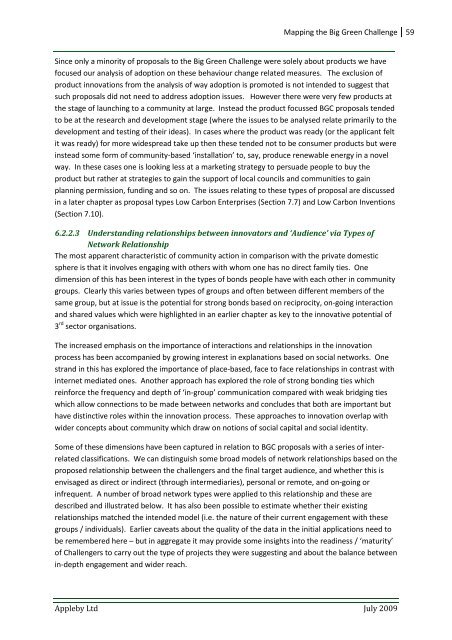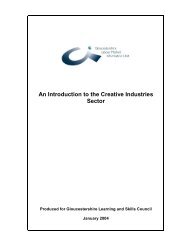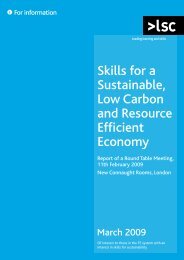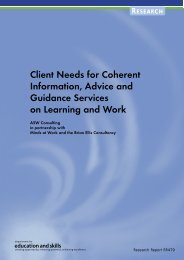Mapping the Big Green Challenge - The Skills & Learning ...
Mapping the Big Green Challenge - The Skills & Learning ...
Mapping the Big Green Challenge - The Skills & Learning ...
Create successful ePaper yourself
Turn your PDF publications into a flip-book with our unique Google optimized e-Paper software.
<strong>Mapping</strong> <strong>the</strong> <strong>Big</strong> <strong>Green</strong> <strong>Challenge</strong> 59Since only a minority of proposals to <strong>the</strong> <strong>Big</strong> <strong>Green</strong> <strong>Challenge</strong> were solely about products we havefocused our analysis of adoption on <strong>the</strong>se behaviour change related measures. <strong>The</strong> exclusion ofproduct innovations from <strong>the</strong> analysis of way adoption is promoted is not intended to suggest thatsuch proposals did not need to address adoption issues. However <strong>the</strong>re were very few products at<strong>the</strong> stage of launching to a community at large. Instead <strong>the</strong> product focussed BGC proposals tendedto be at <strong>the</strong> research and development stage (where <strong>the</strong> issues to be analysed relate primarily to <strong>the</strong>development and testing of <strong>the</strong>ir ideas). In cases where <strong>the</strong> product was ready (or <strong>the</strong> applicant feltit was ready) for more widespread take up <strong>the</strong>n <strong>the</strong>se tended not to be consumer products but wereinstead some form of community-based ‘installation’ to, say, produce renewable energy in a novelway. In <strong>the</strong>se cases one is looking less at a marketing strategy to persuade people to buy <strong>the</strong>product but ra<strong>the</strong>r at strategies to gain <strong>the</strong> support of local councils and communities to gainplanning permission, funding and so on. <strong>The</strong> issues relating to <strong>the</strong>se types of proposal are discussedin a later chapter as proposal types Low Carbon Enterprises (Section 7.7) and Low Carbon Inventions(Section 7.10).6.2.2.3 Understanding relationships between innovators and ‘Audience’ via Types ofNetwork Relationship<strong>The</strong> most apparent characteristic of community action in comparison with <strong>the</strong> private domesticsphere is that it involves engaging with o<strong>the</strong>rs with whom one has no direct family ties. Onedimension of this has been interest in <strong>the</strong> types of bonds people have with each o<strong>the</strong>r in communitygroups. Clearly this varies between types of groups and often between different members of <strong>the</strong>same group, but at issue is <strong>the</strong> potential for strong bonds based on reciprocity, on-going interactionand shared values which were highlighted in an earlier chapter as key to <strong>the</strong> innovative potential of3 rd sector organisations.<strong>The</strong> increased emphasis on <strong>the</strong> importance of interactions and relationships in <strong>the</strong> innovationprocess has been accompanied by growing interest in explanations based on social networks. Onestrand in this has explored <strong>the</strong> importance of place-based, face to face relationships in contrast withinternet mediated ones. Ano<strong>the</strong>r approach has explored <strong>the</strong> role of strong bonding ties whichreinforce <strong>the</strong> frequency and depth of ‘in-group’ communication compared with weak bridging tieswhich allow connections to be made between networks and concludes that both are important buthave distinctive roles within <strong>the</strong> innovation process. <strong>The</strong>se approaches to innovation overlap withwider concepts about community which draw on notions of social capital and social identity.Some of <strong>the</strong>se dimensions have been captured in relation to BGC proposals with a series of interrelatedclassifications. We can distinguish some broad models of network relationships based on <strong>the</strong>proposed relationship between <strong>the</strong> challengers and <strong>the</strong> final target audience, and whe<strong>the</strong>r this isenvisaged as direct or indirect (through intermediaries), personal or remote, and on-going orinfrequent. A number of broad network types were applied to this relationship and <strong>the</strong>se aredescribed and illustrated below. It has also been possible to estimate whe<strong>the</strong>r <strong>the</strong>ir existingrelationships matched <strong>the</strong> intended model (i.e. <strong>the</strong> nature of <strong>the</strong>ir current engagement with <strong>the</strong>segroups / individuals). Earlier caveats about <strong>the</strong> quality of <strong>the</strong> data in <strong>the</strong> initial applications need tobe remembered here – but in aggregate it may provide some insights into <strong>the</strong> readiness / ‘maturity’of <strong>Challenge</strong>rs to carry out <strong>the</strong> type of projects <strong>the</strong>y were suggesting and about <strong>the</strong> balance betweenin-depth engagement and wider reach.Appleby Ltd July 2009











